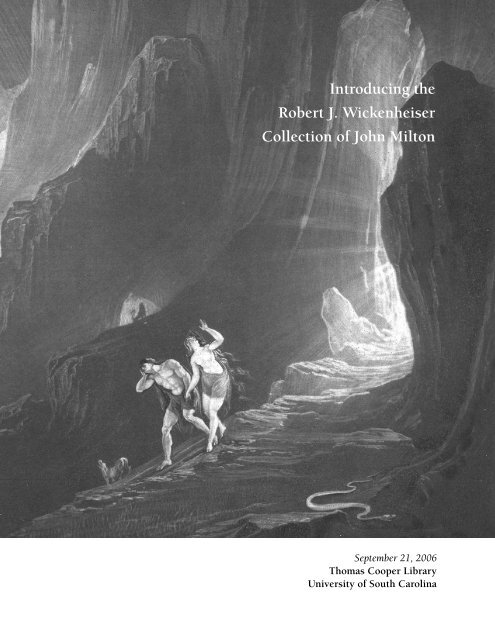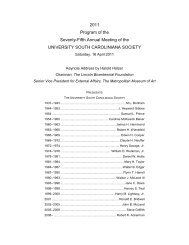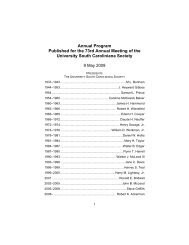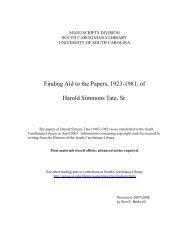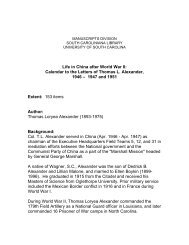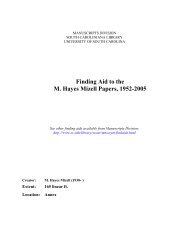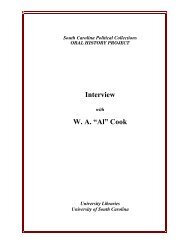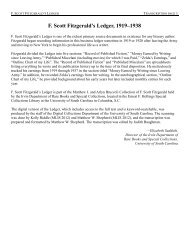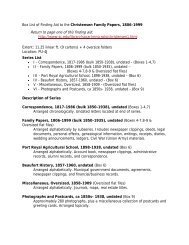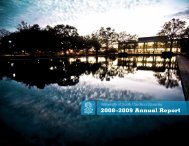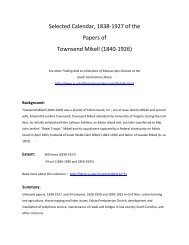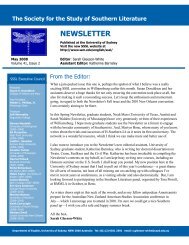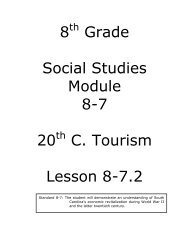Introducing the Robert J. Wickenheiser Collection of John Milton
Introducing the Robert J. Wickenheiser Collection of John Milton
Introducing the Robert J. Wickenheiser Collection of John Milton
You also want an ePaper? Increase the reach of your titles
YUMPU automatically turns print PDFs into web optimized ePapers that Google loves.
<strong>Introducing</strong> <strong>the</strong><br />
<strong>Robert</strong> J. <strong>Wickenheiser</strong><br />
<strong>Collection</strong> <strong>of</strong> <strong>John</strong> <strong>Milton</strong><br />
September 21, 2006<br />
Thomas Cooper Library<br />
University <strong>of</strong> South Carolina
Cover illustration:<br />
Adam and Eve leaving Eden, from<br />
<strong>John</strong> Martin, illus., Paradise Lost, 2 vols.<br />
(London, 1827), with pro<strong>of</strong>s <strong>of</strong> <strong>the</strong><br />
mezzotint illustrations<br />
“Dr. <strong>Robert</strong> <strong>Wickenheiser</strong> is <strong>the</strong> uncontested premier collector <strong>of</strong> <strong>Milton</strong> and<br />
<strong>Milton</strong>iana in <strong>the</strong> world. . . . There is, to <strong>the</strong> best <strong>of</strong> my knowledge, no o<strong>the</strong>r privately<br />
held collection in <strong>the</strong> world that even remotely begins to approach <strong>the</strong> <strong>Wickenheiser</strong><br />
<strong>Milton</strong> <strong>Collection</strong> in scope, range, or importance. . . . The purchase <strong>of</strong> this collection<br />
would immediately catapult <strong>the</strong> purchaser into world-class status.”<br />
— G.W. Stuart Jr.<br />
“ . . . one <strong>of</strong> <strong>the</strong> major collections <strong>of</strong> materials related to <strong>John</strong> <strong>Milton</strong>, editions and<br />
studies and artworks, in <strong>the</strong> world . . . indicating <strong>the</strong> breadth and nature <strong>of</strong> <strong>Milton</strong>’s<br />
position in <strong>the</strong> literary, political, religious, and sociological world over <strong>the</strong> nearly<br />
three and a half centuries since his death.”<br />
— <strong>John</strong> T. Shawcross<br />
“. . . a magnificent collection, in mint condition, preserved under ideal<br />
circumstances, broad in scope, and unique in some <strong>of</strong> its items . . . what has to be<br />
one <strong>of</strong> <strong>the</strong> best private collections <strong>of</strong> <strong>Milton</strong> and <strong>Milton</strong>iana in existence.”<br />
— <strong>John</strong> Mulryan<br />
“Dr. <strong>Wickenheiser</strong>’s collection is . . . a paradise for a scholar <strong>of</strong> seventeenth-century<br />
English literature.”<br />
— Roy Flannagan<br />
“. . . breathtaking in its reach—<strong>Milton</strong> is here but also <strong>Milton</strong>iana, <strong>the</strong> latter<br />
in abundance. This is a collection that, unlike any o<strong>the</strong>r I have seen, represents<br />
<strong>Milton</strong> on an international scene and as an important token <strong>of</strong> his culture.”<br />
— Joseph Wittreich
<strong>Introducing</strong> <strong>the</strong> <strong>Robert</strong> J. <strong>Wickenheiser</strong> <strong>Collection</strong><br />
The <strong>Robert</strong> J. <strong>Wickenheiser</strong> <strong>Collection</strong> <strong>of</strong> <strong>John</strong> <strong>Milton</strong> is a very significant as well<br />
as a very welcome acquisition for <strong>the</strong> University <strong>of</strong> South Carolina and its library. To<br />
support <strong>the</strong> teaching and research <strong>of</strong> a major university, its library must provide both<br />
current resources and distinguished research collections. The <strong>Wickenheiser</strong> collection<br />
brings <strong>the</strong> library its first major seventeenth-century research collection, to join our<br />
earlier acquisition <strong>of</strong> great collections in succeeding centuries. It brings a collection<br />
with <strong>the</strong> depth, scope, and size to support and stimulate a wide range <strong>of</strong> teaching<br />
and research, from <strong>the</strong> undergraduate level upward. It brings to <strong>the</strong> University a<br />
collection that is already widely recognized among scholars in <strong>the</strong> field. We believe<br />
it is a collection that will draw faculty and scholars to South Carolina, to <strong>the</strong><br />
continuing benefit <strong>of</strong> <strong>the</strong> academic community here.<br />
The <strong>Wickenheiser</strong> collection has come to <strong>the</strong> University through <strong>the</strong> generosity and<br />
support <strong>of</strong> three people. Dr. and Mrs. <strong>Wickenheiser</strong>, who had built <strong>the</strong> collection over<br />
a period <strong>of</strong> nearly forty years, held to <strong>the</strong>ir wish that it could be maintained and made<br />
available to future scholars as a single collection, in one library, and to accomplish<br />
that aim accepted a very conservative valuation for purchase. Their cordiality and<br />
helpfulness throughout <strong>the</strong> acquisition process have been much valued.<br />
The leading support for <strong>the</strong> acquisition has been generously provided by Mr. William<br />
L. Richter and <strong>the</strong> William L. Richter Family Foundation. Mr. Richter’s willingness<br />
to visit <strong>the</strong> University, to recognize what <strong>the</strong> collection might accomplish here for <strong>the</strong><br />
University, and to commit <strong>the</strong> lead funding to bring <strong>the</strong> collection here were pivotal<br />
to <strong>the</strong> acquisition.<br />
From <strong>the</strong> library’s first contact with Dr. <strong>Wickenheiser</strong>, in 2004, we recognized that <strong>the</strong><br />
prospect <strong>of</strong> additional space in <strong>the</strong> projected Special <strong>Collection</strong>s library wing would<br />
be crucial if <strong>the</strong> collection is to have <strong>the</strong> greatest long-term benefits to teaching and<br />
research. The Board <strong>of</strong> Trustees has approved naming a dedicated room in <strong>the</strong> new<br />
wing The William L. Richter Room, recognizing Mr. Richter’s generosity and ensuring<br />
that <strong>the</strong> <strong>Wickenheiser</strong> collection will be known and used. President Andrew A. Sorensen<br />
and Provost Mark Becker have both been extremely supportive <strong>of</strong> <strong>the</strong> acquisition <strong>of</strong><br />
<strong>the</strong> <strong>Wickenheiser</strong> collection.<br />
Paul Willis<br />
Dean <strong>of</strong> Libraries<br />
Jonathan Richardson (1665–1745),<br />
sepia drawing <strong>of</strong> <strong>Milton</strong> from clay<br />
bust (ca. 1730)<br />
1
2<br />
A portion <strong>of</strong> <strong>the</strong> <strong>Robert</strong> J. <strong>Wickenheiser</strong><br />
<strong>Collection</strong>, in <strong>the</strong> library <strong>of</strong> <strong>the</strong><br />
<strong>Wickenheiser</strong>s’ home in Olean, N.Y.<br />
Many <strong>of</strong> <strong>the</strong> photographs in this<br />
publication were taken in this room by<br />
Carl V. Margeson, <strong>of</strong> Allegany, N.Y., for<br />
Dr. <strong>Wickenheiser</strong>’s forthcoming book<br />
about <strong>the</strong> collection and are used here<br />
courtesy <strong>of</strong> Dr. <strong>Wickenheiser</strong>.<br />
Richard Westall (1765–1836), “<strong>Milton</strong><br />
Composing Paradise Lost,” hand-colored<br />
aquatint (ca. 1810)<br />
Dr. <strong>Robert</strong> J. <strong>Wickenheiser</strong> started collecting <strong>Milton</strong> and o<strong>the</strong>r seventeenth-century<br />
poets as a graduate student at <strong>the</strong> University <strong>of</strong> Minnesota in <strong>the</strong> late 1960s. As a<br />
young pr<strong>of</strong>essor at Princeton in <strong>the</strong> early seventies, he began focusing on <strong>the</strong> history<br />
<strong>of</strong> <strong>Milton</strong> illustration, and with his wife, Pat, and <strong>the</strong> late <strong>Robert</strong> H. Taylor, past<br />
president <strong>of</strong> <strong>the</strong> Grolier Club, he visited and established friendships with many <strong>of</strong><br />
<strong>the</strong> best-known antiquarian book dealers on both sides <strong>of</strong> <strong>the</strong> Atlantic. The <strong>Milton</strong><br />
collection <strong>of</strong> more than 6,000 volumes that he and Pat built over <strong>the</strong> next 35 years<br />
became a place <strong>of</strong> pilgrimage for <strong>Milton</strong> scholars. Since retiring, Dr. <strong>Wickenheiser</strong><br />
has completed a full-scale illustrated catalogue <strong>of</strong> <strong>the</strong> collection that is scheduled<br />
for publication for <strong>the</strong> <strong>John</strong> <strong>Milton</strong> quatercentenary in 2008.<br />
The <strong>Robert</strong> J. <strong>Wickenheiser</strong> <strong>Collection</strong> <strong>of</strong> <strong>John</strong> <strong>Milton</strong> has been purchased for <strong>the</strong><br />
University with <strong>the</strong> leading support <strong>of</strong> Mr. William L. Richter and <strong>the</strong> William L.<br />
Richter Family Foundation. In recognition and appreciation <strong>of</strong> this generous gift, <strong>the</strong><br />
University’s Board <strong>of</strong> Trustees has approved naming a room in <strong>the</strong> library’s new Special<br />
<strong>Collection</strong>s wing for Mr. Richter, dedicated to housing and selectively displaying <strong>the</strong><br />
<strong>Wickenheiser</strong> collection.<br />
“Books are not absolutely dead things, but do contain a potency <strong>of</strong> life. . . . They<br />
do preserve as in a vial <strong>the</strong> purest efficacy and extraction <strong>of</strong> that living intellect<br />
that bred <strong>the</strong>m. . . . A good book is <strong>the</strong> precious life-blood <strong>of</strong> a master-spirit.”<br />
— <strong>John</strong> <strong>Milton</strong>, Areopagitica (1644)<br />
“The slightest Pamphlet is nowadayes more vendible than <strong>the</strong> Works <strong>of</strong> learnedest<br />
men; but it is <strong>the</strong> love I have to our own Language that hath made me diligent to<br />
collect, and set forth such peeces both in Prose and Verse, as may renew <strong>the</strong> wonted<br />
honour and esteem <strong>of</strong> our English tongue . . . presenting . . . <strong>the</strong>se ever-green, and<br />
not to be blasted Laurels.”<br />
— Humphrey Moseley, <strong>Milton</strong>’s publisher, in Poems (1645)
An Overview <strong>of</strong> <strong>the</strong> <strong>Robert</strong> J. <strong>Wickenheiser</strong><br />
<strong>Collection</strong> <strong>of</strong> <strong>John</strong> <strong>Milton</strong><br />
<strong>John</strong> <strong>Milton</strong> (1608–1674) is <strong>the</strong> most important English-language poet <strong>of</strong> <strong>the</strong><br />
seventeenth century, and central to <strong>the</strong> wider culture <strong>of</strong> his time. He was active in<br />
politics (as author <strong>of</strong> <strong>the</strong> first major text on <strong>the</strong> freedom <strong>of</strong> <strong>the</strong> press and as Latin<br />
secretary to Britain’s revolutionary government in <strong>the</strong> late 1640s and 1650s), deeply<br />
involved in <strong>the</strong> same religious debates as <strong>the</strong> Pilgrim fa<strong>the</strong>rs, and a pioneer also in<br />
his writings on education and on marriage law. He was a learned, even bookish, poet<br />
whose works lead outward to o<strong>the</strong>r writers and thinkers. For centuries after it was<br />
written, his poetry drew responses from poets, learned scholars, ordinary readers,<br />
musicians and composers, and (as <strong>the</strong> <strong>Wickenheiser</strong> collection particularly shows)<br />
artists and illustrators.<br />
The <strong>Robert</strong> J. <strong>Wickenheiser</strong> <strong>Collection</strong> <strong>of</strong> <strong>John</strong> <strong>Milton</strong>, with more than 6,000 volumes,<br />
has both depth and range. Its holdings <strong>of</strong> first and o<strong>the</strong>r seventeenth-century editions<br />
<strong>of</strong> <strong>Milton</strong>’s own writings places this library among <strong>the</strong> top ten <strong>Milton</strong> collections in<br />
North America. The holdings <strong>of</strong> seventeenth-century <strong>Milton</strong>iana—books referring to<br />
<strong>Milton</strong> or o<strong>the</strong>rwise relating to him—are likewise distinguished. The long ranges <strong>of</strong><br />
shelves in <strong>the</strong> collection with eighteenth, nineteenth, and twentieth century <strong>Milton</strong><br />
editions present a comprehensive record <strong>of</strong> <strong>Milton</strong>’s continuing impact, while similarly<br />
comprehensive holdings <strong>of</strong> <strong>Milton</strong> biography, scholarship, and criticism document <strong>the</strong><br />
development <strong>of</strong> knowledge about his writings, thought, and influence.<br />
Dr. <strong>Wickenheiser</strong> has been especially successful in building what is perhaps <strong>the</strong> most<br />
comprehensive collection anywhere <strong>of</strong> <strong>Milton</strong> illustration, from <strong>the</strong> first illustrated<br />
edition in 1688 through all <strong>the</strong> major illustrators that follow, with original drawings<br />
by several <strong>of</strong> <strong>the</strong> artists, and with especial depth for <strong>the</strong> work <strong>of</strong> <strong>John</strong> Martin (1789–<br />
1854) and Gustave Doré (1832–1883).<br />
The <strong>Wickenheiser</strong> collection broadens <strong>the</strong> historical range represented in <strong>the</strong><br />
University’s research collections. It is <strong>the</strong> first major acquisition focused on any<br />
author or topic before <strong>the</strong> mid-eighteenth century. Moreover, <strong>the</strong> breadth <strong>of</strong> <strong>Milton</strong>’s<br />
own interests and <strong>the</strong> international and chronological range <strong>of</strong> those who have<br />
responded to him make this a collection that will stimulate an equally broad range<br />
<strong>of</strong> research projects, across a variety <strong>of</strong> disciplines, both by established researchers<br />
and by students at <strong>the</strong> graduate and undergraduate levels. This is <strong>the</strong> kind <strong>of</strong> special<br />
collection, on a major author <strong>of</strong> central cultural significance, with <strong>the</strong> strength to<br />
support both teaching and research, that any University library should covet. We<br />
salute with gratitude <strong>the</strong> collector and <strong>the</strong> donor who have brought it here to Thomas<br />
Cooper Library.<br />
Patrick Scott<br />
Director <strong>of</strong> Special <strong>Collection</strong>s<br />
Frontispiece portrait from Paradise Lost<br />
(1688), engraved by <strong>Robert</strong> White after<br />
William Faithorne<br />
3
4<br />
<strong>Milton</strong> in <strong>the</strong><br />
Seventeenth Century<br />
The <strong>Robert</strong> J. <strong>Wickenheiser</strong> <strong>Collection</strong><br />
includes more than sixty different<br />
first and o<strong>the</strong>r early editions <strong>of</strong> <strong>Milton</strong><br />
published in <strong>Milton</strong>’s own century.<br />
These cover all phases <strong>of</strong> <strong>Milton</strong>’s<br />
career and all <strong>the</strong> varied aspects<br />
<strong>of</strong> his published writing.<br />
<strong>Milton</strong> as Poet<br />
Leaf with <strong>Milton</strong>’s first published poem,<br />
from <strong>the</strong> Shakespeare Second Folio (1632)<br />
The foundation <strong>of</strong> <strong>Milton</strong>’s significance remains his poetry, and <strong>the</strong><br />
<strong>Wickenheiser</strong> collection includes <strong>Milton</strong>’s first published poem,<br />
his tribute to William Shakespeare, published while he was still a<br />
student at Cambridge.<br />
<strong>Milton</strong>’s Early Recognition<br />
<strong>Milton</strong>’s Poems English and Latin (1645)<br />
From his first published collection in 1645, which<br />
included tributes from Italian scholars, <strong>Milton</strong>’s<br />
stature as a poet was recognized not only by<br />
English readers, but also internationally.<br />
The <strong>Wickenheiser</strong> collection has a fine copy<br />
<strong>of</strong> <strong>the</strong> 1645 collection, with <strong>the</strong> Marshall portrait.<br />
<strong>Milton</strong>’s Historical Importance<br />
<strong>Milton</strong>’s Eikonoklastes (1649)<br />
<strong>Milton</strong> was deeply engaged in <strong>the</strong> English political revolution <strong>of</strong><br />
<strong>the</strong> mid-seventeenth century, both as pamphleteer and as Latin<br />
Secretary to <strong>the</strong> Commonwealth after <strong>the</strong> execution <strong>of</strong> King<br />
Charles I. The <strong>Wickenheiser</strong> collection includes first editions<br />
<strong>of</strong> many <strong>of</strong> his political writings.<br />
Five variant issues<br />
<strong>of</strong> Paradise Lost (1667–69)<br />
Paradise Lost<br />
At <strong>the</strong> heart <strong>of</strong> <strong>the</strong> <strong>Wickenheiser</strong> collection<br />
are five fine copies <strong>of</strong> <strong>the</strong> first edition <strong>of</strong><br />
<strong>Milton</strong>’s masterwork, <strong>the</strong> epic Paradise Lost<br />
(1667). The collection includes five <strong>of</strong> <strong>the</strong> six<br />
variant issues traditionally identified from <strong>the</strong><br />
first edition, which was arranged in ten epic<br />
books ra<strong>the</strong>r than <strong>the</strong> twelve <strong>of</strong> <strong>the</strong> second<br />
and later editions.
Illustrated Editions <strong>of</strong> Paradise Lost<br />
The first illustrated edition (1688)<br />
The initial focus <strong>of</strong> Dr. <strong>Wickenheiser</strong>’s <strong>Milton</strong> collecting<br />
was <strong>Milton</strong> illustration, and <strong>the</strong> collection has all three variant<br />
issues for <strong>the</strong> first illustrated edition, <strong>the</strong> fourth folio (1688),<br />
with twelve engravings chiefly by J.B. Medina. Shown here is<br />
<strong>the</strong> expulsion from Eden.<br />
Books that Influenced <strong>Milton</strong><br />
DuBartas, His Divine Weekes and Workes (1605)<br />
In addition to <strong>Milton</strong>’s own works, <strong>the</strong> <strong>Wickenheiser</strong><br />
collection has more than fifty related seventeenth-century<br />
items. Of writers that influenced <strong>Milton</strong>, <strong>the</strong> collection has<br />
first editions <strong>of</strong> Giovanni Andreini (1617), Phineas Fletcher<br />
(1633), Thomas Heywood (1635), and George Sandys (1636),<br />
as well as several editions <strong>of</strong> Sallust DuBartas.<br />
Contemporary Reaction to <strong>Milton</strong><br />
Judgment and Decree <strong>of</strong> <strong>the</strong> University <strong>of</strong> Oxford (1683)<br />
<strong>Milton</strong>’s political views made him a controversial figure to<br />
his contemporaries. In addition to books mentioning and<br />
commenting on <strong>Milton</strong>’s poetry by George Sikes, Joshua Poole,<br />
<strong>John</strong> Phillips, Patrick Hume, and o<strong>the</strong>rs, <strong>the</strong> <strong>Wickenheiser</strong><br />
collection has items like this, <strong>the</strong> University’s condemnation <strong>of</strong><br />
“pernicious books and damnable doctrines,” including <strong>Milton</strong>’s.<br />
<strong>Milton</strong> as Political Thinker<br />
The first edition <strong>of</strong> Areopagitica (1644)<br />
<strong>Milton</strong>’s ideas on controversial issues—church-state<br />
relations, marriage law, education, and <strong>the</strong> rights <strong>of</strong> those<br />
governed to remove <strong>the</strong> government—were <strong>of</strong> lasting<br />
influence. His 1644 letter to Parliament, Areopagitica, was<br />
a milestone in establishing <strong>the</strong> freedom <strong>of</strong> <strong>the</strong> press.<br />
“By labour and intent study . . .<br />
I might perhaps leave something<br />
so written to after-times, as <strong>the</strong>y<br />
should not willingly let it die.”<br />
— <strong>John</strong> <strong>Milton</strong> (1641)<br />
5
6<br />
<strong>Milton</strong> in <strong>the</strong><br />
Eighteenth and<br />
Nineteenth Centuries<br />
The <strong>Wickenheiser</strong> collection contains<br />
holdings in depth charting <strong>Milton</strong>’s<br />
readership and influence in <strong>the</strong><br />
eighteenth and nineteenth centuries.<br />
These holdings in particular hold<br />
<strong>the</strong> potential for a wide variety <strong>of</strong><br />
research projects, not only on <strong>Milton</strong>,<br />
but on his publishers, illustrators,<br />
biographers, and commentators<br />
and on <strong>the</strong> developing history<br />
<strong>of</strong> book production.<br />
The Growth <strong>of</strong> <strong>Milton</strong>’s Influence<br />
Joseph Addison’s copy <strong>of</strong> Paradise Lost (1711)<br />
Among items documenting <strong>Milton</strong>’s influence is<br />
this unassuming edition, once owned by <strong>the</strong> poet<br />
and critic Joseph Addison (1672–1719), given to<br />
Dr. <strong>Wickenheiser</strong> in 1980 by <strong>the</strong> late <strong>John</strong> Fleming,<br />
to whom it came from <strong>the</strong> legendary Dr. A.S.W.<br />
Rosenbach. The first separate edition <strong>of</strong> Addison’s<br />
influential essays on <strong>Milton</strong> is also in <strong>the</strong><br />
<strong>Wickenheiser</strong> collection.<br />
<strong>Milton</strong>’s International Reputation<br />
Paradise Lost (Paris, 1792), with color illustrations<br />
The <strong>Wickenheiser</strong> collection documents <strong>Milton</strong>’s extraordinary<br />
international influence, with early translations that include Latin,<br />
German, French, Dutch, and Italian. The French edition shown<br />
here (in a sumptuous binding) pioneered a new technique for<br />
direct color printing, ra<strong>the</strong>r than hand-colored engravings.<br />
<strong>Milton</strong> and His Editors<br />
Paradise Lost (1727), interleaved<br />
with manuscript annotations<br />
The <strong>Wickenheiser</strong> collection also<br />
documents how editors wrestled<br />
over <strong>the</strong> texts and interpretation<br />
<strong>of</strong> <strong>Milton</strong>’s poetry. This specially<br />
interleaved copy preserves <strong>the</strong><br />
copious and detailed annotations<br />
<strong>of</strong> its mid-eighteenth-century owner.<br />
<strong>Milton</strong> and America<br />
The first American edition <strong>of</strong><br />
Paradise Lost (1777)<br />
<strong>Milton</strong> was as influential in America as in Europe,<br />
and not only among <strong>the</strong> Puritans. The Revolution<br />
freed Americans from British copyright, and <strong>the</strong><br />
<strong>Wickenheiser</strong> collection includes not only <strong>the</strong><br />
first American editions <strong>of</strong> <strong>Milton</strong>’s poetry but also<br />
rare printings <strong>of</strong> political pamphlets, influential in<br />
debates on <strong>the</strong> Constitution and Bill <strong>of</strong> Rights.
Francis Hayman (1708–1776)<br />
Hayman, “Satan, Sin & Death”<br />
The <strong>Wickenheiser</strong> collection has two<br />
original Hayman watercolors. The subject<br />
<strong>of</strong> this one is also treated by several o<strong>the</strong>r<br />
artists, including Hogarth and (in political<br />
caricatures) Rowlandson and Gilray.<br />
Henry Richter (ca. 1770–ca. 1820)<br />
Richter, original drawing (ca. 1794)<br />
Henry Richter’s illustrations for Paradise Lost were published in<br />
1794. In addition to <strong>the</strong> published versions, <strong>the</strong> <strong>Wickenheiser</strong><br />
collection has a portfolio with twelve <strong>of</strong> Richter’s original<br />
drawings for <strong>the</strong> series.<br />
<strong>John</strong> Martin<br />
Original mezzotint pro<strong>of</strong> for Paradise Lost (1825)<br />
The Romantic or apocalyptic landscapes by<br />
<strong>John</strong> Martin (1791–1855) are among <strong>the</strong> greatest <strong>of</strong><br />
<strong>Milton</strong> illustrations. The <strong>Wickenheiser</strong> collection<br />
has an extraordinary range <strong>of</strong> <strong>the</strong> published editions<br />
<strong>of</strong> Martin’s work, including this pro<strong>of</strong> for his first<br />
mezzotint edition. Ano<strong>the</strong>r Martin pro<strong>of</strong> is used<br />
on <strong>the</strong> cover <strong>of</strong> this publication.<br />
Gustave Doré<br />
Doré’s <strong>Milton</strong> in original parts (1866)<br />
Among <strong>the</strong> most widely popular mid-nineteenth-century <strong>Milton</strong><br />
illustrations were those by <strong>the</strong> French illustrator Gustave Doré<br />
(1832–1883). Doré’s work was marketed using all <strong>the</strong> resources<br />
<strong>of</strong> Victorian mass publishing, including part issues (as here) and<br />
multiple variant bindings. The <strong>Wickenheiser</strong> collection includes<br />
all <strong>the</strong>se, along with Doré’s o<strong>the</strong>r illustrated works.<br />
<strong>Milton</strong> and<br />
His Illustrators<br />
The <strong>Wickenheiser</strong> collection’s<br />
comprehensive holdings <strong>of</strong> illustrated<br />
editions <strong>of</strong> <strong>Milton</strong> include many<br />
rare variant issues and editions and<br />
a number <strong>of</strong> original drawings and<br />
separately issued engravings by such<br />
artists as Francis Hayman, Thomas<br />
Rowlandson, James Gilray, Henry<br />
Richter, Henry Fuseli, Richard Westall,<br />
Henry Howard, <strong>John</strong> Martin, <strong>John</strong> Bell,<br />
and Gustave Doré.<br />
7
8<br />
<strong>Milton</strong> and <strong>the</strong><br />
History <strong>of</strong> <strong>the</strong> Book<br />
A collection <strong>of</strong> this depth not only<br />
illustrates its own special field but<br />
also provides research opportunities<br />
in many adjacent disciplines. The<br />
<strong>Wickenheiser</strong> collection is especially<br />
valuable in <strong>the</strong> research materials it<br />
provides for <strong>the</strong> growing research<br />
interest in book production and<br />
<strong>the</strong> history <strong>of</strong> <strong>the</strong> book.<br />
<strong>Milton</strong> and Fine Printing<br />
Paradise Lost (Golden Cockerel, 1937)<br />
The <strong>Wickenheiser</strong> collection includes editions <strong>of</strong> <strong>Milton</strong> by<br />
influential printers and book designers from <strong>John</strong> Baskerville<br />
in <strong>the</strong> eighteenth century through to <strong>the</strong> modern fine printing<br />
movement, with examples from <strong>the</strong> Daniel Press, Eragny Press,<br />
Vale Press, Doves Press, Chiswick Press, Cresset Press, Nonesuch,<br />
Golden Cockerel, Rampant Lion Press, and Whittington Press.<br />
Fine Bindings<br />
Paradise Lost (1688), in contemporary black morocco<br />
Many <strong>of</strong> <strong>the</strong> volumes in <strong>the</strong> <strong>Wickenheiser</strong> collection have been<br />
specially bound, and in addition to such earlier fine bindings as<br />
<strong>the</strong> one illustrated, <strong>the</strong> collection contains examples by many<br />
<strong>of</strong> <strong>the</strong> major binders <strong>of</strong> <strong>the</strong> late nineteenth and early twentieth<br />
centuries: <strong>the</strong> Doves Bindery, Rivière, Sangorski and Sutcliffe,<br />
Bayntun, and o<strong>the</strong>rs.<br />
The Development <strong>of</strong> Book Production Techniques<br />
Victorian decorated cloth bindings<br />
The scale <strong>of</strong> <strong>the</strong> collection means that it also includes, generally in fine condition, a very full<br />
range <strong>of</strong> examples <strong>of</strong> book production history, from seventeenth-century folios (and pamphlets),<br />
through <strong>the</strong> paper-covered boards <strong>of</strong> <strong>the</strong> late eighteenth century, through <strong>the</strong> evolution <strong>of</strong><br />
publishers’ decorated cloth bindings in <strong>the</strong> nineteenth century.<br />
<strong>Milton</strong> Scholarship and Reference<br />
The primary materials in <strong>the</strong> <strong>Robert</strong> J. <strong>Wickenheiser</strong> <strong>Collection</strong> are supported by a full range <strong>of</strong><br />
<strong>the</strong> scholarship on <strong>Milton</strong>, including modern biographies, critical monographs, editions, specialist<br />
journals, auction and booksellers’ catalogues, and reference works relating to <strong>Milton</strong> illustrators<br />
and <strong>the</strong> history <strong>of</strong> illustration techniques. Many <strong>of</strong> <strong>the</strong>se books are inscribed to Dr. <strong>Wickenheiser</strong><br />
by <strong>the</strong>ir authors.
Rare Books and Special <strong>Collection</strong>s at Thomas Cooper Library<br />
The University <strong>of</strong> South Carolina (<strong>the</strong>n South Carolina College) started building its library<br />
collections in 1803. By 1850, with 25,000 volumes, it had <strong>the</strong> largest library collection south<br />
<strong>of</strong> Washington, D.C., housed in <strong>the</strong> first purpose-built free-standing college library building.<br />
Many <strong>of</strong> <strong>the</strong> valuable books acquired during that time period are still in <strong>the</strong> library’s care and<br />
form <strong>the</strong> core <strong>of</strong> <strong>the</strong> current Special <strong>Collection</strong>s. Since <strong>the</strong> mid-twentieth century, <strong>the</strong> libraries<br />
as a whole have grown exponentially until, with more than 3.3 million volumes, USC’s libraries<br />
constitute a major research and teaching resource for <strong>the</strong> University, <strong>the</strong> community, <strong>the</strong> state,<br />
and <strong>the</strong> nation. USC has <strong>the</strong> only nationally ranked research library in <strong>the</strong> state and <strong>the</strong> only<br />
S.C. membership in <strong>the</strong> Association <strong>of</strong> Research Libraries.<br />
The Department <strong>of</strong> Rare Books and Special <strong>Collection</strong>s at Thomas Cooper Library has also<br />
grown dramatically in recent years. Its special mission is to acquire, preserve, and make<br />
available distinctive (<strong>of</strong>ten rare or valuable, sometimes unique) materials and collections,<br />
such as books, manuscripts, and o<strong>the</strong>r materials, in support <strong>of</strong> teaching and research. Over<br />
<strong>the</strong> past twenty years <strong>the</strong> department’s holdings have grown sixfold, attracting international<br />
scholarly attention and adding significant new collections, largely through generous response<br />
to an expanded gift program, in <strong>the</strong> areas <strong>of</strong> philosophy (Hume, Russell); history (Garibaldi),<br />
exploration (Renaissance maps), military history (Civil War, World War I), and military<br />
aviation (World War II); natural history (eighteenth century watercolors, Abbot) and <strong>the</strong><br />
history <strong>of</strong> science (Darwin, Babbage); English literature (<strong>Milton</strong>), Scottish literature (Ramsay,<br />
Burns, Carlyle, Stevenson, MacDiarmid), and American literature (Emerson, Fuller, Whitman,<br />
<strong>John</strong>son, Fitzgerald, Hemingway, Heller, Dickey); children’s literature (Rawlings, African-<br />
American); and <strong>the</strong> history <strong>of</strong> <strong>the</strong> book.<br />
Over <strong>the</strong> same period, <strong>the</strong> department has also added new initiatives in <strong>the</strong> areas <strong>of</strong> teaching,<br />
exhibits, digitization, and scholarly and public programs. Its community organization, <strong>the</strong><br />
Thomas Cooper Society, founded in 1990, now has more than 600 members. An extensive<br />
series <strong>of</strong> Web exhibits and Web projects based on <strong>the</strong> collections has been attracting more<br />
than 25 million hits a year.<br />
When it opens in 2008, <strong>the</strong> department’s new home, part <strong>of</strong> a multistage plan to modernize<br />
and upgrade physical facilities for all USC libraries, will provide attractive space for all <strong>the</strong>se<br />
activities—exhibits, teaching, public programs, and digital projects as well as expanded and<br />
up-to-date study space for researchers, enhanced environmental conditions and security for<br />
both people and books, and much increased and upgraded stack space to ensure <strong>the</strong> long-term<br />
availability <strong>of</strong> <strong>the</strong>se extraordinary collections.<br />
The University <strong>of</strong> South Carolina is an equal opportunity institution. 06497 University Publications 9/06<br />
The Thomas Cooper Library’s new<br />
west wing will provide space for <strong>the</strong><br />
collections and services <strong>of</strong>fered by<br />
<strong>the</strong> Department <strong>of</strong> Rare Books and<br />
Special <strong>Collection</strong>s.
Books are not absolutely dead things, but do contain a potency <strong>of</strong> life. . . .<br />
A good book is <strong>the</strong> precious life-blood <strong>of</strong> a master-spirit.<br />
Rare Books & Special <strong>Collection</strong>s<br />
Thomas Cooper Library<br />
— <strong>John</strong> <strong>Milton</strong>, Areopagitica (1644)


